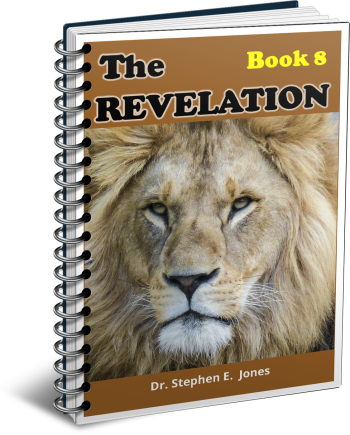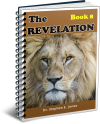Latest Posts
View the latest posts in an easy-to-read list format, with filtering options.

A study of Revelation 20-22. This is book 8 of an 8 part book series.
Category - Bible Commentaries

Regarding the New Jerusalem, we read in Rev. 21:22,
22 And I saw no temple in it, for the Lord God, the Almighty, and the Lamb [arnion], are its temple.
John says that there is no physical temple in the New Jerusalem, for it is unnecessary. The city has a better temple that Paul said was being built upon the foundation of the apostles and prophets, with Jesus Christ being the corner stone (Eph. 2:20-22). This is the true temple, not a physical, rebuilt temple in Jerusalem that so many are expecting.
This temple includes more than “the Lord God” and Jesus Christ. It includes the body of Christ as well. Jesus is the amnos (“Lamb” of God) in John 1:29 and 36. The arnion are those whom Peter was to feed and to care for in John 21:15. As we have already shown earlier, John never uses the word amnos in the book of Revelation. It is always arnion, and it refers to the complete Head and body of Christ.
In other words, John affirms Paul’s statement in 1 Cor. 3:16, “Do you not know that you are a temple of God?” That temple has taken thousands of years to build, for it must include people from every generation until the emergence of the New Jerusalem, where the temple is complete. This is the temple that Haggai foresaw in Haggai 2:9, whose glory would be greater than the temple of Solomon.
Revelation 21:23 continues,
23 And the city has no need of the sun or of the moon to shine upon it, for the glory of God has illumined it, and its lamp is the Lamb.
John was referring to the prophecy in Isaiah 60:19,
19 No longer will you have the sun for light by day, nor for brightness will the moon give you light; but you will have the Lord for an everlasting light, and your God for your glory.
When Jesus was transfigured on the mount in Matt. 17:2, the light within Him shined forth in radiance:
2 And He was transfigured before them; and His face shone like the sun, and His garments became as white as light.
We must also compare this to Moses’ experience, when he came off another mount with his face shining. Exodus 34:29 says,
29 And it came about when Moses was coming down from Mount Sinai (and the two tablets of the testimony were in Moses’ hand as he was coming down from the mountain), that Moses did not know that the skin of his face shone because of his speaking with Him.
At that time, Moses found it necessary to veil his face in order not to frighten the people, because even though this was a New Covenant experience, he ministered to Old Covenant people. But this veil is removed in Christ, Paul says in 2 Cor. 3:13-16,
13 and are not as Moses, who used to put a veil over his face that the sons of Israel might not look intently at the end of what was fading away. 14 But their minds were hardened; for until this very day at the reading of the old covenant the same veil remains unlifted, because it is removed in Christ. 15 But to this day whenever Moses is read, a veil lies over their heart; 16 but whenever a man turns to the Lord, the veil is taken away.
The light shining from Moses’ face was veiled to hide the light, but the veil did not hinder Moses’ vision, but rather the vision of those under the Old Covenant. In other words, those who depend upon their Old Covenant vows to save them have a veil over their heart, preventing them from being transfigured like Moses. That veil is removed only when men have faith in the promises of God and the Mediator of the New Covenant, who is called to bring to pass those things that God has promised by the strength of His own will.
When Christians today place their faith in their own ability to make good on their vows of obedience, they remain under the Old Covenant, and “a veil lies over their heart.” In other words, they are yet ineligible for transfiguration, for the light is unable to penetrate the Old Covenant veil. Other evidence of such a veil is set forth by their inability to see beyond a physical temple in Jerusalem where they think Jesus will live and where Levitical priests will make animal sacrifices on its altar.
The New Jerusalem has its own light source coming from within. It needs no light from the sun or moon. We are not told if there will even be a sun or moon in those days, for John’s focus is upon the inner light.
Revelation 21:24 continues,
24 And the nations shall walk by its light, and the kings of the earth shall bring their glory into it.
This is a reference to Isaiah 60:3,
3 And nations will come to your light, and kings to the brightness of your rising.
Again, it is plain that Isaiah was not speaking of the old Jerusalem, but of the new, for this is how John interprets and applies the prophecy. This has a dual fulfillment. First, the nations and kings “bring their glory into it,” that is, into the city. Secondly, the nations “walk by its light,” that is, by the revelation of truth coming from Christ and His body (temple).
This assumes that nations and kings continue to exist at that time. In order for Christ to be “King of kings,” there must be kings. In order for Christ to be “Lord of lords,” there must be lords. Hence, kings, nations, and national boundaries will continue to exist while the nations learn the ways of God. It is not an instantaneous transformation of all things on earth. Isaiah 2:2, 3 says,
2 … and all nations will stream to it. 3 And many peoples will come and say, “Come, let us go up to the mountain of the Lord, to the house of the God of Jacob; that He may teach us concerning His ways, and that we may walk in His paths.” For the law will go forth from Zion, and the word of the Lord from Jerusalem.
While many today apply this to the earthly Jerusalem and to the earthly “Zion,” John applies the prophecy to the New Jerusalem. Furthermore, Heb. 12:22 says,
22 But you have come to Mount Zion [Sion, KJV] and to the city of the living God, the heavenly Jerusalem, and to myriads of angels…
This “Mount Zion” is associated with the heavenly Jerusalem, not with the earthly city by the same name. It is, in fact, Mount Sion, or Mount Hermon, which is the place where Jesus was transfigured. Deut. 4:48 tells us that Mount Sion is Mount Hermon. Hence, Mount Sion is the prophetic place where the people of the New Covenant gather to participate in Jesus’ transfiguration experience. Nonetheless, this place of transfiguration now transcends any earthly location, for even Mount Hermon (Sion) was only a type of something greater.
Revelation 21:25-27 concludes,
25 And in the daytime (for there shall be no night there) its gates shall never be closed; 26 and they shall bring the glory and the honor of the nations into it; 27 and nothing unclean and no one who practices abomination and lying shall ever come into it, but only those whose names are written in the Lamb’s book of life.
John was referring to Isaiah 60:11, saying,
11 And your gates will be open continually; they will not be closed day or night, so that men may bring to you the wealth [chayil, “strength, wealth, ability, resources”] of the nations, with their kings led in procession.
Where Isaiah speaks of the chayil (“resources”) of the nations being brought to Jerusalem, John interprets this to mean “the glory and honor of the nations.” This is the true wealth of the nations. It is not about setting up an oppressive tax upon other nations, as many carnally-minded and vindictive men have taught.
It refers to the fact that these kings understand and believe fully that they are mere stewards of whatever portions of the earth they have been given and that Jesus Christ is the rightful Heir of all things. Therefore, all of their resources are used for the glory and honor of God, as was the intent of the Creator from the beginning. The gates of the city will be open continually. In past times, city gates were closed at night, but in this great city there is no night.
During this time, it appears that there will still be people who are unable to gain access to the city. For this reason, though the gates remain open, the walls remain, and only those who “praise” the Lord can enter the city. No doubt the number of ineligible people will diminish over time, but yet John implies in Rev. 21:27 that there are still those who practice “abomination and lying.”
John was probably alluding to the prophecy in Isaiah 52:1,
1 Awake, awake, clothe yourself in your strength, O Zion; Clothe yourself in your beautiful garments, O Jerusalem, the holy city, for the uncircumcised and the unclean will no more come into you.
Although this is expressed in Old Covenant terms, it has a New Covenant fulfillment. True circumcision is not outward, but inward (Rom. 2:28, 29), and the unclean are those who have not been washed by the blood of Christ and the water of the word (John 15:3).
Joel 3:17 also prophesies,
17 Then you will know that I am the Lord your God, dwelling in Zion My holy mountain. So Jerusalem will be holy, and strangers [zur, “foreigners”] will pass through it no more.
This is not an ethnic statement about Jerusalem being for Israelites only. This is plain, because it was never against the law for a foreigner to visit the city or its temple. In fact, the temple was to be a house of prayer for all people (Isaiah 56:6, 7), including foreigners. This was known even to Solomon when he dedicated his temple for all men to worship God, regardless of ethnicity (1 Kings 8:41-43).
Hence, the term “foreigner” refers to someone who has not been cleansed by the word and who has not received heart circumcision, which is the sign of the New Covenant. John says that the only ones who will have access to the city are “those whose names are written in the Lamb’s book of life.” The list includes those who have been begotten by God, not those who have been begotten by natural flesh. These, Paul says, “are no longer strangers and aliens,” but “are fellow citizens with the saints” (Eph. 2:19).
This ends chapter 21 of the book of Revelation, but John’s description of the New Jerusalem continues into the next chapter.